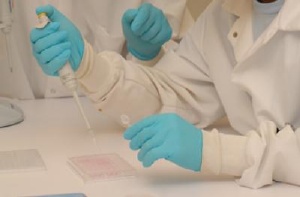Jun 16 2009
Nanoparticles specially engineered by University of Central Florida Assistant Professor J. Manuel Perez and his colleagues could someday target and destroy tumors, sparing patients from toxic, whole-body chemotherapies.
 Dr. Manuel Perez and his team have been investigating the use of nanoparticles for medicine for years. Credit: Jacque Brund
Dr. Manuel Perez and his team have been investigating the use of nanoparticles for medicine for years. Credit: Jacque Brund
Perez and his team used a drug called Taxol for their cell culture studies, recently published in the journal Small, because it is one of the most widely used chemotherapeutic drugs. Taxol normally causes many negative side effects because it travels throughout the body and damages healthy tissue as well as cancer cells.
The Taxol-carrying nanoparticles engineered in Perez's laboratory are modified so they carry the drug only to the cancer cells, allowing targeted cancer treatment without harming healthy cells. This is achieved by attaching a vitamin (folic acid) derivative that cancer cells like to consume in high amounts.
Because the nanoparticles also carry a fluorescent dye and an iron oxide magnetic core, their locations within the cells and the body can be seen by optical imaging and magnetic resonance imaging (MRI). That allows a physician to see how the tumor is responding to the treatment.
The nanoparticles also can be engineered without the drug and used as imaging (contrast) agents for cancer. If there is no cancer, the biodegradable nanoparticles will not bind to the tissue and will be eliminated by the liver. The iron oxide core will be utilized as regular iron in the body.
"What's unique about our work is that the nanoparticle has a dual role, as a diagnostic and therapeutic agent in a biodegradable and biocompatible vehicle," Perez said.
Perez has spent the past five years looking at ways nanotechnology can be used to help diagnose, image and treat cancer and infectious diseases. It's part of the quickly evolving world of nanomedicine.
The process works like this. Cancer cells in the tumor connect with the engineered nanoparticles via cell receptors that can be regarded as "doors" or "docking stations." The nanoparticles enter the cell and release their cargo of iron oxide, fluorescent dye and drugs, allowing dual imaging and treatment.
"Although the results from the cell cultures are preliminary, they are very encouraging," Perez said.
A new chemistry called "click chemistry" was utilized to attach the targeting molecule (folic acid) to the nanoparticles. This chemistry allows for the easy and specific attachment of molecules to nanoparticles without unwanted side products. It also allows for the easy attachment of other molecules to nanoparticles to specifically seek out particular tumors and other malignancies.
Perez's study builds on his prior research published in the prestigious journal Angewandte Chemie Int. Ed. His work has been partially funded by a National Institutes of Health grant and a Nanoscience Technology Center start-up fund.
"Our work is an important beginning, because it demonstrates an avenue for using nanotechnology not only to diagnose but also to treat cancer, potentially at an early stage," Perez said.